Ngorongoro Crater
 |
 |
 |
 |
After that exciting start we headed down the dusty path into the caldera. The first thing we saw were zebra (first and second photo), and these were among the most commonly seen animals that day. Like so many animals, they had no qualms about walking near or in front of our vehicle. For better or worse, they had become accustomed to the presence of tourists. In the third picture below a herd of wildebeest graze, and in the fourth a lone male lion scans the horizon. His mame wasn't fully developed and it didn't appear as though he had his own pride yet.
 |
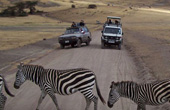 |
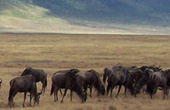 |
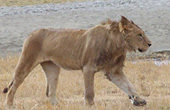 |
In the set below are ostriches (first) and Thomson's gazelles (second), both of which were also commonly seen on the Serengeti. I really liked Ngorongoro because the small dimensions ensured we would see certain animals. The black rhinoceros pictured in the third photo below was the only one we saw in Africa. The fourth picture is one of the many hippopotamus pools we came across. Hippos are dangerous and kill more people each year than any other animal in Africa, usually after someone inadvertently blocks their retreat to water.
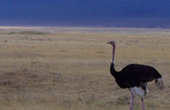 |
 |
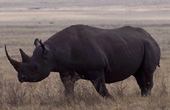 |
 |
The first image in the set below shows some of the more (in)famous scavengers of Africa. Vultures had begun eating what I presume was the carcass of a dead animal, but before long hyenas chased them off to eat it themselves as the vultures looked on in envy. In the second picture a warthog grubs for roots and bulbs. Typically they eat grasses and bark, but in winter months like these they must sometimes improvise. The third picture features another elephant bull who, like the first, seemed happy to see us. The fourth picture below nicely shows how zebras and wildbebeest often associate together when they graze.
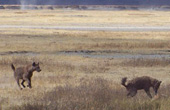 |
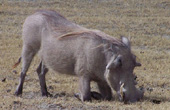 |
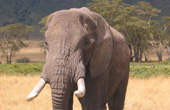 |
 |
As midday approached we had lunch at a nearby clearing in the crater, and since it wasn't closed off to the wildlife around it added a certain element of excitement. The first picture below was taken at lunch and shows our game viewing technique. The second shows one of the many vervet monkeys that had snatched up some of our food. The third shows a lioness casually checking us out. Some moments later she joined up with some friends and harrassed a herd of wldebeest, pictured in the fourth photo below. The lions didn't seem to be trying too hard and almost looked to be having more fun toying with them.
 |
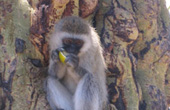 |
 |
 |
We continued to drive around in Ngorongoro and saw many of the same animals already shown here. Soon we left and headed for the great Serengeti. Click here for that, or click on the safari link above.